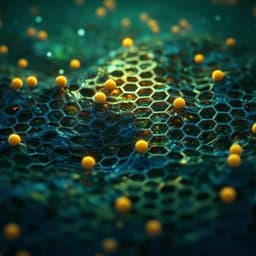
Biology
Engineering artificial photosynthesis based on rhodopsin for CO₂ fixation
W. Tu, J. Xu, et al.
This groundbreaking research by Weiming Tu, Jiabao Xu, Ian P. Thompson, and Wei E. Huang introduces an innovative artificial photosynthesis system that harnesses rhodopsin's proton-pumping capabilities and integrates microbial carbon fixation to significantly enhance CO₂ conversion efficiency.
Playback language: English
Introduction
Microbial CO₂ fixation through photosynthesis is fundamental to the global carbon cycle, contributing significantly to primary productivity. Photosynthetic microbes utilize either chlorophyll or rhodopsin-based systems for light harvesting. Chlorophyll-based systems are complex, involving photosystems I and II and an electron transport chain. Rhodopsin-based systems are simpler, utilizing light-activated proton pumps. While evidence suggests rhodopsins can support ATP synthesis for inorganic carbon assimilation with organic electron donors, they cannot solely drive CO₂ fixation due to the lack of electron generation. Microbial rhodopsins are widespread, and their potential role in carbon fixation is significant. Recent studies have demonstrated that rhodopsin phototrophy can generate sufficient energy to reverse electron transfer, enabling NADH synthesis and powering CO₂ fixation. The proton gradient generated by rhodopsin supports NAD(P)H regeneration via an ETC, driving CO₂ reduction. This research aims to engineer a system using rhodopsin to drive CO2 fixation in a non-photosynthetic bacterium, specifically *R. eutropha*, by integrating it with an efficient electron transfer system, building on previous work demonstrating rhodopsin-based photoelectrosynthesis in engineered *E.coli* and *R. eutropha* which used an external electrode and electron-shuttling molecules. The current system exhibits a low electron transfer rate and efficiency. It is hypothesized that creating an efficient electron transfer interface on the cell membrane could increase electron transport from electrode to the cells, and increase the efficiency of the overall system. Therefore, this study will integrate the use of the outer-membrane-bound Mtr pathway, which naturally facilitates bidirectional electron transfer in *S. oneidensis* MR-1. It is proposed that combining extracellular electron uptake with intracellular reverse electron transfer can construct a synthetic photosynthetic ETC. Increasing the proton-pumping activity of rhodopsin will also increase the efficiency.
Literature Review
Extensive research demonstrates the use of microbial rhodopsins as optogenetic tools in synthetic biology. Engineered bacteria expressing rhodopsins convert light energy into intracellular chemical energy, improving bioproduction in the light. For instance, rhodopsin expression in *E. coli* enhances bioproduction, and in the electroactive bacterium *S. oneidensis*, it powers electrosynthesis of reduced products. Integrating rhodopsin-based photosystems with chemoautotrophic bacteria is a promising strategy for increasing biosynthesis from CO₂. Chemoautotrophic bacteria utilize inorganic chemicals or electrodes as electron donors for CO₂ assimilation. *R. eutropha* H16, a chemolithoautotroph, is a model chassis due to its CO₂ fixation pathway and metabolic versatility. Previous work engineered *R. eutropha* H16 with *Gloeobacter* rhodopsin (GR) and an external electrode, creating a redox loop mediated by an electron-shuttling molecule. Although effective, this system had a low electron transfer rate. Natural electroactive bacteria, like *S. oneidensis* MR-1, utilize the Mtr pathway for bidirectional electron transfer. Similarly, *Rhodopseudomonas palustris* TIE-1 employs outer-membrane cytochromes for electron transfer. Combining extracellular electron uptake with intracellular reverse electron transfer is hypothesized to create a synthetic photosynthetic ETC in *R. eutropha*. The proton-pumping capacity is another limiting factor, affecting ATP and NADH synthesis. The proton gradient drives ATP production and reverses proton-translocating NADH dehydrogenase for reducing equivalent regeneration. Thus, increasing rhodopsin's proton-pumping activity may enhance system efficiency.
Methodology
This study engineered *R. eutropha* H16 to express the MtrCAB complex from *S. oneidensis* MR-1 and GR from *Gloeobacter violaceus*. This design enables an electrochemically driven photosynthetic ETC. Engineered *R. eutropha* directly takes electrons from a cathode via the Mtr pathway, using the proton motive force from light-activated rhodopsin for ATP and NAD(P)H synthesis. The photoelectrosynthetic *R. eutropha* was integrated with a solar-driven electrochemical system for artificial photosynthesis. Flavin and canthaxanthin were introduced to improve electron transfer rate and proton-pumping capacity, respectively. β-carbonic anhydrase (*can*) was overexpressed to enhance CO₂ fixation. A plasmid containing the *MtrCAB* gene cluster (P<sub>Llo11a</sub>-*MtrCAB*) under an arabinose-inducible promoter was created and transferred into *R. eutropha* H16 to create *R. eutropha*-Mtr. Single-cell Raman analysis confirmed Mtr expression, showing increased cytochrome bands. Electrochemical tests confirmed Mtr function; in the presence of nitrate, *R. eutropha*-Mtr consumed current more rapidly due to Mtr-mediated electron transfer. To achieve artificial photosynthesis using light energy, a solar panel drove the electrochemical platform. A voltage regulator stabilized the cathode potential to protect cells. *R. eutropha* Δ*pha* (RHM5) was used to maximize carbon flux towards biomass. FMN was added as an electron mediator. Single-cell Raman analysis showed FMN binding to MtrC. *R. eutropha* RHM5-GR-Mtr strains were inoculated in bioelectrochemical reactors with -1.7 V applied voltage under light or dark conditions. The results showed that cells grew on CO2 in the presence of light, but not in the dark. The addition of canthaxanthin doubled the ApH compared to the strain with GR alone. Overexpression of *can* further reduced generation time. Single-cell Raman analysis confirmed the incorporation of 13C from bicarbonate into biomass. A dual-chamber bioreactor separated by a Nafion membrane was used to reduce the effects of anodic oxygen generation.
Key Findings
The engineered *R. eutropha* successfully performed photoelectron-autotrophic growth and fixed CO₂ powered by the light-driven ETC. The addition of exogenous flavin as an electron shuttle increased the electron transfer rate. The Mtr pathway almost halved the doubling time and increased faradaic efficiency to 35.4% from 23.9% compared to *R. eutropha* RHM5-GR using flavin alone. The total charge transfer increased by 54.4%. Canthaxanthin's addition further decreased the doubling time by 22% and increased efficiency by 21%. Overexpression of *can* reduced the generation time to 67.3 h, comparable to *Rhodopseudomonas palustris*. The faradaic efficiency reached 45.0%. The system is similar to *R. palustris*, but the mechanisms differ. The engineered *R. eutropha* uses rhodopsin for proton motive force, coupling proton movement with electron transfer for CO₂ fixation, while *R. palustris* uses P870 for electron transfer. The study found that MtrCAB expression enhances extracellular electron transfer in *R. eutropha*, although the enhancement is limited compared to other heterologous microorganisms. This limitation could be due to low MtrCAB expression, which can be improved by codon and ribosome binding site optimization and adding precursors like 5-aminolevulinic acid. The addition of proteins like periplasmic small tetraheme cytochrome (STC) may further enhance electron transfer. The reverse electron transfer from the quinol pool to NAD is thermodynamically unfavorable and requires a high proton motive force to drive protons back through NADH dehydrogenase. Increasing light intensity or using canthaxanthin as an antenna improves proton pumping. The study addressed concerns about ROS generation by using a dual-chamber reactor separated by a Nafion membrane. The system's simplicity contrasts with natural photosynthesis. The complementary light absorption of chlorophyll and rhodopsin suggests integrating them to maximize solar energy utilization. The modular design allows for optimization via electrode modification, extending rhodopsin's light absorption. Microbial rhodopsins' significance in ocean solar energy harvesting is noted, along with the potential for syntrophic metabolisms and inorganic minerals as electron sources for bacteria growth.
Discussion
This research successfully established an artificial photosynthetic system in the non-phototrophic bacterium *R. eutropha*, providing a potential model for transforming other non-photosynthetic bacteria. The system mimics natural photosynthesis, using a light-powered electrochemical system to split water (like photosystem II) and rhodopsin to generate proton motive force for NADH/NADPH regeneration (like photosystem I). The Mtr complex acts as an interface between the cathode and the intracellular ETC. The system avoids H₂ generation, using a low potential (-1.7 V) and ensuring that the Mtr-mediated electron transfer is the major mechanism. The engineered *R. eutropha* is similar to *R. palustris*, both being phototrophic but lacking photosystem II. However, their mechanisms differ: the engineered *R. eutropha* employs rhodopsin to generate proton motive force, while *R. palustris* naturally uses P870 for electron transfer. The native biomolecules play an important role, and further investigation is required to fully understand the interplay between Mtr expression, electron transfer, and proton motive force. Addressing challenges like limited MtrCAB expression in *R. eutropha* requires further optimization. The study highlighted the importance of the proton motive force for reversing the function of NADH dehydrogenase, which is crucial for regenerating NADH. The potential of the highly reduced quinol pool and the proton motive force generated by rhodopsin facilitate this process. The study addressed the potential issue of ROS generation by using a dual-chamber reactor. This research offers a significant step toward creating efficient artificial photosynthetic systems that can effectively use light energy to drive CO₂ fixation for sustainable applications.
Conclusion
This study successfully demonstrated an artificial photosynthetic system in *R. eutropha*, showcasing the potential of engineering non-photosynthetic bacteria into photoelectrotrophs. The system's modular design allows for further optimization and expansion to other bacteria. Future research should focus on improving MtrCAB expression, exploring additional protein incorporation, and optimizing the system's energy efficiency and ROS management.
Limitations
While this study demonstrated successful CO₂ fixation in the engineered *R. eutropha*, further research is needed to optimize MtrCAB expression, fully elucidate the electron transfer mechanisms, and evaluate the long-term stability and scalability of the system. Additionally, while the use of the dual-chamber reactor mitigates ROS formation, it may not fully replicate natural conditions. The comparison to naturally occurring photosynthetic systems is made based on an analogy of the processes involved, but a direct comparison is not yet available.
Related Publications
Explore these studies to deepen your understanding of the subject.







